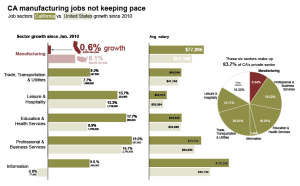
Fox and Hounds Daily Says Goodbye
With this article, we end publication of Fox and Hounds Daily. It has been a satisfying 12½ year run. When we opened in May 2008, our site was designed to offer an opportunity to those who wished to engage in public debate on many issues, especially in politics and business, but found it difficult to get placed in newspaper op-ed pages.
Co-publishers Tom Ross, Bryan Merica and I have kept F&H going over this time investing our own time, funding, and staff help. Last year at this time we considered closing the site, however with an election on the horizon we decided to keep F&H going through the election year. With the election come and gone, and with no sense of additional resources, we have decided to close the site down.
Fox and Hounds will live on, at least, with my articles collected in the California State Library.
On a personal note, I have spent over 40 years in California policy and politics. There have been some incredible high moments and some difficult low points. It pains me that politics too often is a blood sport, frequently demonizing the motives of opponents and using the legal system as a weapon in public discourse. At Fox & Hounds, we tried to adhere to the practice of giving all a voice in the debate, yet keep the commentaries civil and avoided personal attacks.
F&H offered the opportunity to publish different perspectives (even ones that criticized my writings!). We had success as indicated by the Washington Post twice citing Fox and Hounds Daily one of the best California political websites and many other positive affirmations and comments received over the years.
Tom, Bryan and I want to thank our many readers and writers for being part of our journey. The publishers of Fox and Hounds Daily believe that we added value to California and its people. We hope you agree.
The Water Bond Is Another Missed Opportunity
If the state of California could tax self-congratulation over missed political opportunities, we might have the money to rebuild our water infrastructure.
The water bond placed on the ballot by the legislature is of a piece with other less than impressive triumphs of the Brown Era. Presented with events and political possibilities to make big progress on a crucial issue, political leaders choose something small that doesn’t change all that much.
In water, the state’s needs – just to meet existing population and existing repair – run into tens, if not hundreds of billions of dollars. And this year, with a historic drought, the time was right for a fix. The state already had an $11 billion bond on the ballot that – despite constant criticism of it by the governor and media as full of pork – was doing well in polls. (more…)
Is Litigation Costing You Your Kid’s Education?
As Californians prepare to send their children back to school, local school districts are preparing to welcome students, teachers, and staff back into the classroom. In recent years, however, high litigation costs have contributed to cutbacks in school budgets placing added pressure on the budgets of school districts, parents and teachers.
California Citizens Against Lawsuit Abuse has just released its 2014 School Litigation Report, which analyzed the litigation costs to 12 districts for fiscal years 2010-2011 through 2012-2013. The report found that the districts combined spent more than $125.6 million on litigation, spending $96.1 million on outside counsel, and $29.4 million on verdicts and settlements. The report can be read here.
That’s $125 million that districts spent on litigation instead of providing their students an education. Worse, because the districts examined account for less than 20 percent of the total enrollment of California’s K-12 public school districts, the total economic impact of litigation to the state’s education system is likely much higher than the cost reported here. (more…)
A Look at Growth in Manufacturing and Other Sectors vs. The U.S.
In light of 4,600 new California manufacturing jobs reported in July, we thought we’d take a look at how some of the largest job sectors were doing against the rest of the country since we began to come out of the recession in 2010. The CMTA chart below shows each sector’s growth and average salary in both California and the U.S. It also shows the percentage of the private sector job base that each of these sectors account for in California. In total it shows our state needs to find ways to attract more manufacturing. Upticks like we saw in July are promising but California must keep it up.
Click the image for larger picture.
Vergara Appeal Decision
To an astounding degree, prominent California Democrats have so far avoided substantive comment on Judge Rolf Treu’s landmark — but tentative – June 10 ruling in Los Angeles Superior Court that teacher tenure laws are so harmful to minority students in poor neighborhoods that it “shocks the conscience.”
A spokesman for Attorney General Kamala Harris told me repeatedly that the AG’s office wasn’t deciding on whether to appeal. He said Harris would do what her clients wanted. Gov. Jerry Brown and state Superintendent of Public Instruction Tom Torlakson are named plaintiffs in the case, and if either or both want to appeal, I was told, Harris would then appeal.
Treu is expected to issue a final ruling by Sept.10, at which point an appeal decision must be finalized.
2000s Job Growth Continues to Follow Population
The United States lost jobs between 2000 and 2010, the first loss between census years that has been recorded in the nation’s history. The decline was attributable to two economic shocks, the contraction following the 9/11 attacks and the Great Recession, the worst financial crisis since the Great Depression. Yet, even in this moribund job market, employment continued to disperse in the nation’s major metropolitan areas.
This is the conclusion of a small area analysis (zip code tabulation areas) of data from County Business Patterns, from the Census Bureau, which captures nearly all private sector employment and between 85 and 90 percent of all employment (Note 1).
The small area analysis avoids the exaggeration of urban core data that necessarily occurs from reliance on the municipal boundaries of core cities (which are themselves nearly 60 percent suburban or exurban, ranging from as little as three percent to virtually 100 percent). This “City Sector Model” small area analysis method is described in greater detail in Note 2. (more…)
Napa Earthquake
Earthquake Information for California Residents
- In California, residential earthquake coverage can be purchased through the California Earthquake Authority (CEA).
- A CEA policy must be in place for insurance coverage to be available.
- Aftershocks that occur within 360 hours (15 days) of the main earthquake will be considered a part of the same quake.
- The CEA policy provides coverage for emergency repairs, up to $1,500. These repairs are NOT subject to a deductible.
- CEA policies also include coverage for additional living expenses when you’re unable to stay in your home due to earthquake damage.
Information provided by State Farm



